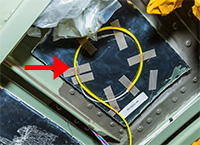Research & Development
JAXA promotes three research and development programs and a fundamental research program that underpins them.
Eco-wing technology
JAXA has completed the first flight tests on its optical fiber-based strain sensor
On November 8 and 11, 2016, JAXA conducted flight tests for its HOTALW (High performance Optical fiber sensor flight Tests for AirpLane Wing) project. The purpose was to examine whether JAXA’s distributed strain measurement system using optical fiber sensors (OFDR-FBG system) could function properly as designed under actual flight conditions.
For the flight tests, optical fiber sensors were bonded to the fuselage stringer (longeron) and bulkhead of "Hisho", JAXA’s jet research aircraft. For comparison, conventional strain gauge sensors were attached to Hisho, as well. After having taken off from Nagoya Airport, the aircraft performed several operations required to obtain strain data over the Pacific, such as making steady banking turns at 45° and 60° bank angles, moving elevators up and down, and changing cabin pressure levels, and then returned to Nagoya Airport.
Preliminary analysis showed that the OFDR-FBG system properly captured small deformations of Hisho’s airframe during the takeoff, flight, and landing procedures as intended. To evaluate the accuracy of the OFDR-FBG system, researchers are carrying out in-depth analysis by comparing measured data from OFDR-FBG system with the corresponding measurement data from conventional strain gauge sensors.
In FY2017, JAXA is planning to place the OFDR-FBG sensors on the lower surface of the main wings to measure the strain that they experience during flight. Thus, JAXA is planning to verify the applicability of the OFDR-FBG system to various structures for effective distributed strain measurement.
Once the OFDR-FBG technology has been fully developed to cover various parts of aircraft structures with sensing fibers, users will be able to determine load distribution and assess airframe structural conditions in detail. Access to detailed data on the loads affecting specific airframe sections will also facilitate optimal airframe design, allowing designers to use thinner configurations for components that have minimal strength requirements. Eventually, the information will also help designers design lighter airframe structures and improve fuel efficiency. Another potential benefit of OFDR-FBG technology is that it will enable constant monitoring of airframe conditions and quickly alert users of any damage or deformation, which will make aircraft maintenance and operations more efficient.

Optical fiber installed in the airframe
(The yellow cable indicated by the red arrow)
December 21, 2016